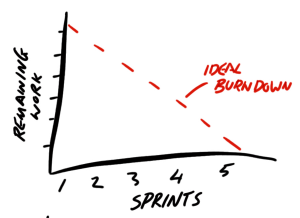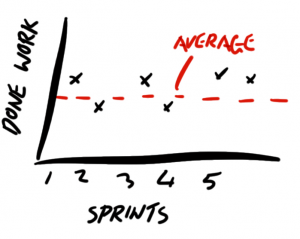Scrum Simulation With Dice
Jump to navigation
Jump to search
Learning Outcomes
This exercise provides some experience using a dice based simulation of Scrum with some agile metrics to record progress at both the Sprint and release level, and discover the strategies that you and your team can use to cope with responding to change.
Prerequisites
A prerequisite for this exercise is that a Product Backlog exists with items that have been estimated such as the end point of the My Sweet 16 Birthday Party exercise.
Timings
Allow 40 mins for this exercise.
Materials
- Dice, enough for pairs of attendees to be able to throw up to 3 dice
- Marker pens
- Release and Sprint burn down charts
Connections
- Write on large post it notes headers called "Product Backlog", "To Do", "Doing" and "Done"
- Arrange for the items created in the pre-requisite exercise to be placed under the "Product Backlog" heading
- Arrange the "To Do", "Doing" and "Done" in order at the top of the workspace so that items can be placed under neath them
- Select which items are to be done in the first Sprint and place these under the "To Do" heading
The Items to be done in the first Sprint should now be under the "To Do" heading with the rest under the "Product Backlog" heading and ready to start the simulation.
Concrete Practice
- As a team sum up the total number of story points for all of the items in the "Product Backlog" and "To Do" columns
- Divide the total number of story points on the Product Backlog by 150. This is the number of dice to now request from the facilitator.
- On the Release Burndown chart mark off the total number of story points on the vertical axis, and calculate the divisions on the vertical axis. (For example, if my total number of story points on my Product Backlog is 100, then I will put 100 on the top of the vertical axis and mark off 10 story points for each division on the vertical axis.)
- Finally, draw the ideal burn down line from the total number of story points on the vertical axis to Sprint 5 on the horizontal axis. (This should provide a diagonal line from the total amount of work down to zero by Sprint 5.)
- Repeat steps 1, 3 and 4 for the Sprint 1 Burndown chart, but this time only for the items in the "To Do" column for Sprint 1. (The end result should be a total number of story points for Sprint 1 on the vertical axis, the vertical axis divided into equal divisions, and a diagonal line from the top of the vertical axis to day 5 on the horizontal axis.)
- DO NOT GO BEYOND SPRINT 1 at this point
- Working on Sprint 1, throw the dice. The total numbers from the dice throw now represent the work that was completed on day 1.
- On the Sprint 1 Burndown Chart decrement the dice throw (work done) for day 1 from the total number of story points and mark how much work is remaining on the chart for day 1.
- Mark off the completed story points from the items in the "To Do" column to represent the work that was done on those items. If any items are done then put them in the "Done" column.
- Repeat step 7 to 9 for each of the remaining 4 days for Sprint 1. (If the burndown chart shows that the work is completing ahead of time, bring in an additional item into the "To Do" column from the "Product Backlog" and mark off how much work is remaining with the new item.)
- The first Sprint has now been completed.
- Next update the Velocity chart with the total work completed for Sprint 1. (This should be around half way up the vertical axis, as future Sprints may deliver more or less work.)
- Going back to the Release Burndown chart, decrement the work done for Sprint 1 from the total amount of work and mark how much total work is remaining on the chart after Sprint 1.
- Performing a Sprint Review adjust the release plan on the Product Backlog by rearranging the work planned for the future Sprints based upon the velocity. (Any items not completed in Sprint 1 should now be moved to the "Product Backlog" column and the "To Do" column cleared ready for the next sprint.)
- Repeat steps 5 – 14 for the remainder of the Sprints and adjusting the "Product Backlog" as you go to provide the best possible value with respect to the velocity.
- Call over the facilitator for review and discussion.
Closure
- Reflect on the exercise with some suggested questions:
- What scoping decisions did you have to make?
- How did this affect your release plan?
- What does this tell you about having a sense of flexibility and options in the Product Backlog?


